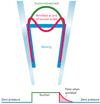Stretch-activated ion channels: what are they?
- PMID: 20134028
- PMCID: PMC2924431
- DOI: 10.1152/physiol.00042.2009
Stretch-activated ion channels: what are they?
Abstract
Mechanosensitive ion channels (MSCs) exist in all cells, but mechanosensitivity is a phenotype not a genotype. Specialized mechanoreceptors such as the hair cells of the cochlea require elaborate mechanical impedance matching to couple the channels to the external stress. In contrast, MSCs in nonspecialized cells appear activated by stress in the bilayer local to the channel--within about three lipids. Local mechanical stress can be produced by far-field tension, amphipaths, phase separations, the cytoskeleton, the extracellular matrix, and the adhesion energy between the membrane and a patch pipette. Understanding MSC function requires under standing the stimulus.
Figures



References
-
- Andersen OS, Nielsen C, Maer AM, Lundb’k JA, Goulian M, Koeppe RE. Ion channels as tools to monitor lipid bilayer-membrane protein interactions: gramicidin channels as molecular force transducers. Methods Enzymol. 1999;294:208–224. - PubMed
-
- Beech DJ. TRPC1: store-operated channel and more. Pflügers Arch. 2005;451:53–60. - PubMed
-
- Besch SR, Suchyna T, Sachs F. High-speed pressure clamp. Pflügers Arch. 2002;445:161–166. - PubMed
-
- Bett GCL, Sachs F. Whole-cell mechanosensitive currents in rat ventricular myocytes activated by direct stimulation. J Membr Biol. 2000;173:255–263. - PubMed
Publication types
MeSH terms
Substances
Grants and funding
LinkOut - more resources
Full Text Sources
Molecular Biology Databases

